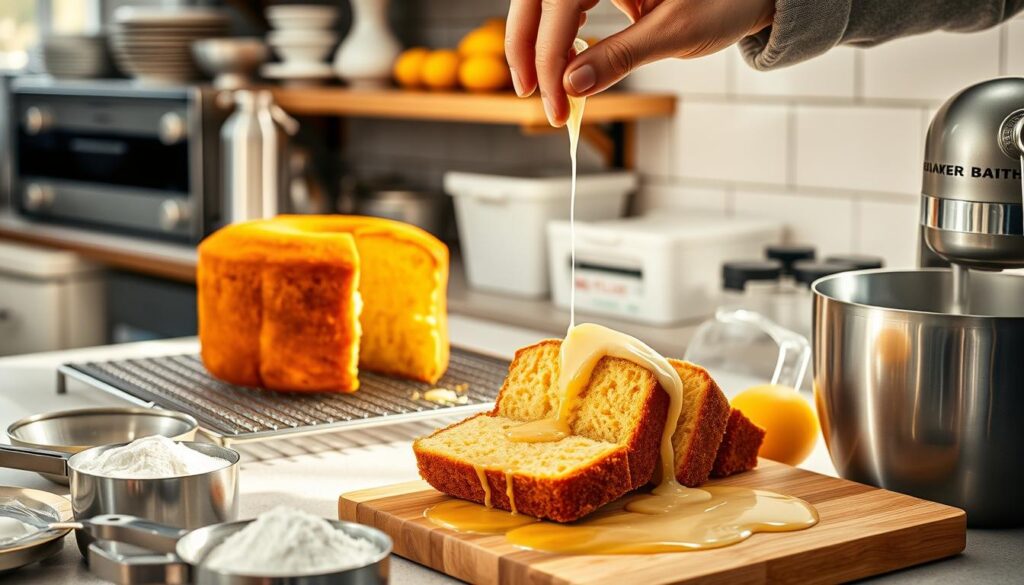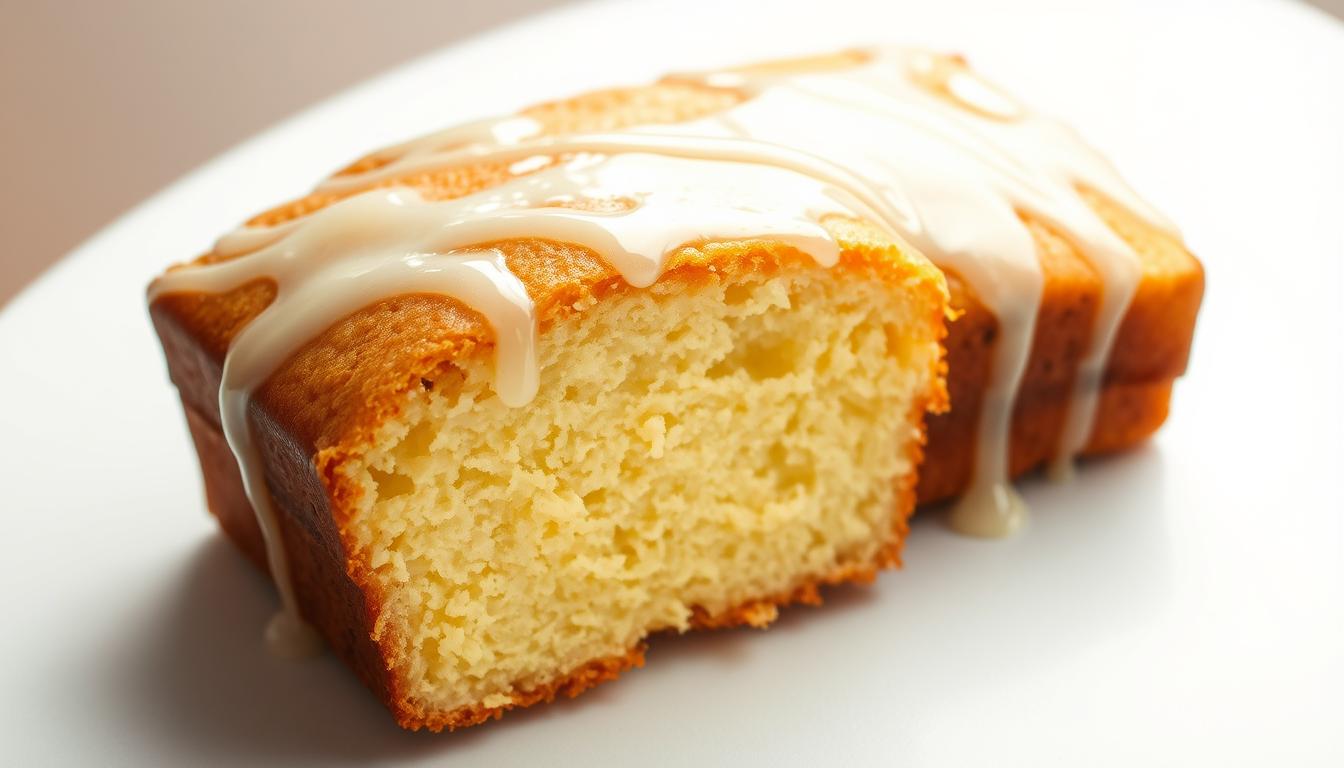Table of Contents
Every kitchen has a special recipe that makes moments unforgettable. For me, it’s the lemon glazed pound cake. It’s a dessert that feels like a warm hug with its buttery texture and citrusy taste.
This isn’t just any pound cake. It’s a journey that brings people together through a single slice of joy.
Imagine stepping into a kitchen filled with the scent of freshly baked pound cake. The lemon glaze makes this classic dessert even more special. Whether you’re an experienced baker or just starting out, these 10 recipes will inspire you to make something amazing.
Each recipe in this collection finds the perfect mix of cake and lemon glaze. You’ll see how pound cake recipes can be both traditional and innovative.
Key Takeaways
- Discover 10 unique lemon glazed pound cake recipes
- Learn the secrets to creating the perfect pound cake texture
- Explore the rich culinary tradition behind this classic dessert
- Master the art of balancing sweet and tart flavors
- Transform your baking skills with professional techniques
Why Lemon Glazed Pound Cake Stands Out Among Desserts
Explore the world of traditional pound cake, a favorite in American baking for many years. The lemon glazed pound cake is a mix of rich cake and zesty flavors. It’s a dessert that truly stands out.
This treat has a long history that spans centuries. It started in Europe with a simple yet elegant approach to desserts. This approach became a key part of American baking.
History of Traditional Pound Cake
The name “pound cake” comes from its original recipe. It had one pound each of flour, butter, eggs, and sugar. This made a dense, rich cake that Americans loved. Bakers then started adding new flavors and techniques to the classic recipe.
- Originated in European baking traditions
- Named for its original equal-pound ingredient proportions
- Evolved to include various flavor variations
The Perfect Balance of Sweet and Tart
Lemon glazed pound cake is known for its amazing taste. It’s a top pick in the sweet and tart desserts category. The buttery cake is the perfect base for the tangy lemon glaze, making every bite refreshing.
Cultural Significance in American Baking
Pound cake is more than just a dessert in American baking. It’s a symbol of comfort, tradition, and creativity. It’s a favorite at family gatherings and community events, bringing people together with its delicious taste.
Essential Ingredients for the Perfect Pound Cake
Making a delicious lemon glazed pound cake begins with picking the right ingredients. The ingredients you choose are key to the cake’s flavor and texture.
For a great pound cake, you need top-notch ingredients. Here are the main ones:
- Butter: Choose unsalted, high-fat European-style butter for the best taste
- Eggs: Use fresh, room-temperature large eggs for better mixing and structure
- Sugar: Granulated white sugar adds the right sweetness
- Flour: All-purpose flour makes the cake dense and classic
- Lemons: Use fresh, organic lemons for zest and juice
Knowing how each ingredient works is important for success. Here’s how they help your pound cake:
| Ingredient | Function | Pro Tip |
|---|---|---|
| Butter | Creates rich flavor and tender crumb | Cream until light and fluffy |
| Eggs | Provides structure and moisture | Always use room temperature |
| Sugar | Adds sweetness and helps with caramelization | Sift to remove lumps |
| Flour | Gives cake its characteristic density | Measure precisely |
| Lemons | Adds bright, citrusy flavor | Use fresh zest and juice |
The quality of your ingredients affects the cake’s taste. Pick fresh, high-quality items and follow each step carefully. This way, you’ll make a dessert that’s unforgettable.
The Secret to Achieving the Perfect Cake Texture
To make a perfect pound cake, you need to master certain baking techniques. These techniques affect your cake’s texture. Professional bakers start preparing long before they turn on the oven. They understand how ingredients work together.
Getting the right cake texture is all about a few key things. Home bakers can easily do these things. How you handle ingredients and mix them can turn a simple dessert into a special treat.
Room Temperature Ingredients Matter
Ingredients at room temperature are key for a smooth cake. Cold ingredients can mess up mixing, leading to a dense cake.
- Butter should be soft but not melted
- Eggs need to sit at room temperature for 30 minutes before mixing
- Use a digital thermometer to check ingredient temperatures
Proper Mixing Techniques
Knowing how to mix is important. The creaming method creates air pockets for a light cake. This is a key baking technique.
| Mixing Stage | Recommended Technique | Duration |
|---|---|---|
| Creaming Butter/Sugar | Medium speed | 3-5 minutes |
| Adding Eggs | Low speed | 30-45 seconds |
| Final Mixing | Minimal stirring | Until just combined |
Baking Temperature Guidelines
Using the right baking temperature is important. A moderate oven temperature, like 325-350°F, helps bake evenly. This prevents burning the outside.
- Preheat oven completely before baking
- Use light-colored metal pans for even heat distribution
- Check cake doneness with a toothpick test
Remember, patience and precision are your greatest allies in creating a pound cake with an impeccable texture.
Making the Ultimate Lemon Glaze
Making the perfect lemon glaze turns a simple pound cake into a showstopper. With just a few ingredients and some basic steps, your citrus icing can take your baking to the next level.
To make an amazing lemon glaze, you’ll need a few key things:
- Powdered sugar
- Fresh lemon juice
- Lemon zest
- Optional: Vanilla extract
The secret to a great lemon glaze is getting the right consistency. Start by sifting your powdered sugar to get rid of any lumps. This makes your glaze smooth and silky, perfect for drizzling over your pound cake.
How you mix the glaze is important. Slowly add lemon juice to the powdered sugar while stirring constantly. Strive for a consistency that’s easy to pour, not too thick or too thin. If it’s too thin, add more powdered sugar. If it’s too thick, add a bit more lemon juice.
Pro tip: Add lemon zest directly to the glaze for a stronger citrus flavor. The zest’s natural oils will make your glaze even more vibrant and complex.
When you’re ready to apply the icing, make sure your pound cake is completely cool. Pour the glaze over the top and let it flow down the sides for a beautiful, rustic look.
Common Mistakes to Avoid When Baking Pound Cake

Baking a perfect pound cake needs precision and care. Many home bakers face challenges that can ruin their dessert. Knowing common mistakes helps make a delicious, moist, and well-textured pound cake every time.
Measuring Ingredients with Precision
Getting the right measurements is key in making pound cake. Mistakes often come from not measuring ingredients correctly. Here are some tips for accurate measurements:
- Use a digital kitchen scale for weight measurements
- Avoid using liquid measuring cups for dry ingredients
- Level off dry ingredients with a straight edge
- Measure ingredients at room temperature
Mastering Cake Pan Preparation
Properly preparing your cake pan is vital. Poor preparation can cause cakes to stick and bake unevenly. Here’s how to prepare your cake pan:
- Grease the pan thoroughly with butter or baking spray
- Dust the pan with flour, tapping out excess
- Use parchment paper for easy cake removal
- Choose the right pan size specified in the recipe
Perfecting Your Baking Timing
Timing is critical when baking a pound cake. Overbaking makes it dry and tough, while underbaking leaves it dense and raw. Check if it’s done by inserting a toothpick into the center. It should come out clean with just a few crumbs.
Remember, every oven is different. Use an oven thermometer for accurate temperature. Also, rotate your cake halfway through baking for even heat.
Storage Tips to Maintain Freshness
Storing your cake right is key to keeping its taste and texture great. Knowing how to store it well means you can enjoy it for days after baking.
How long you want to keep the cake affects how you store it. For quick enjoyment, room temperature is best. But for longer, refrigeration or freezing is better.
Room Temperature Storage
- Store cake in an airtight container
- Keep away from direct sunlight
- Maintain room temperature between 68-72°F
- Consume within 2-3 days for optimal taste
Refrigeration Techniques
For longer freshness, refrigeration is the way to go. Wrap the cake well to avoid moisture loss and flavor changes from other foods.
| Storage Method | Duration | Recommended Wrapping |
|---|---|---|
| Plastic Wrap | 3-4 days | Tight, multiple layers |
| Cake Carrier | 5-6 days | Sealed, with lid |
Freezing for Extended Preservation
Freezing is the best for keeping cake for a long time. Wrap individual slices or the entire cake in plastic wrap, followed by aluminum foil. This keeps it fresh and tasty for up to three months.
- Wrap cake tightly to prevent freezer burn
- Label with date of freezing
- Thaw at room temperature before serving
By using these storage tips, your lemon glazed pound cake will stay fresh and delicious for a long time.
Seasonal Variations and Flavor Combinations
Turn your classic lemon glazed pound cake into exciting seasonal treats. Try new flavor combinations to make this traditional dessert fresh and interesting all year.
Seasonal desserts let you play with unique ingredients. Your pound cake can change with the seasons and special events. It becomes a canvas for your culinary creativity.
Summer Berry Additions
Add summer vibrancy to your citrus desserts with fresh berries. Try these delightful mix-ins:
- Fold fresh strawberries into the batter for a burst of sweetness
- Sprinkle blueberries on top before baking for color and flavor
- Create a raspberry compote to drizzle over the finished cake
Holiday Spice Variations
Winter is for warm, comforting flavors. Add these festive spices to your pound cake:
- Add ground cinnamon for a classic holiday touch
- Mix in nutmeg for a rich, aromatic profile
- Incorporate ginger for a subtle, warming kick
Citrus Combinations
While lemon is classic, try other citrus flavors for exciting variations. Experiment with these zesty alternatives:
- Replace lemon with orange zest for a sweeter profile
- Use lime for a tangy, tropical twist
- Combine multiple citrus fruits for a complex flavor
Remember, creativity and experimentation are key to great seasonal desserts. Each variation adds a unique twist to the classic pound cake. Every slice is a new adventure.
Serving Suggestions and Presentation Ideas
To make your lemon glazed pound cake truly special, focus on presentation and serving ideas. The right touch can turn a simple dessert into a memorable treat.
For a stunning dessert presentation, consider these elegant serving tips:
- Choose decorative plates that match the cake’s golden color
- Top with fresh ingredients for a pop of color
- Use height and dimension on the plate
How you serve your dessert can greatly enhance the dining experience. Here are some advanced presentation techniques:
- Lightly dust the plate with powdered sugar for a fancy look
- Surround the cake with fresh berries
- Drizzle extra lemon glaze in artistic patterns
| Garnish Option | Flavor Profile | Visual Impact |
|---|---|---|
| Fresh Mint Leaves | Refreshing | Bright Green Contrast |
| Candied Lemon Peel | Citrusy | Glistening Texture |
| Whipped Cream | Creamy | Soft White Backdrop |
Pair your lemon glazed pound cake with drinks like Earl Grey tea or a light espresso. This will make your dessert experience even more refined.
Troubleshooting Your Lemon Glazed Pound Cake
Making the perfect lemon glazed pound cake can be tough. Even skilled bakers face texture and glaze problems. Knowing how to fix these issues can make your cake turn out great every time.
Every baker has to deal with challenges when making the perfect pound cake. Spotting and fixing texture problems early can save your cake and improve your baking.
Fixing Common Texture Issues
The texture of your lemon glazed pound cake is key. If it’s too dense or dry, try these fixes:
- Use room temperature ingredients for better mixing
- Avoid overmixing the batter, which can create a tough texture
- Check your oven temperature with an accurate thermometer
- Measure ingredients precisely to maintain proper moisture
Glaze Consistency Solutions
Getting the glaze just right takes practice and focus. Glaze problems often come from wrong sugar-to-liquid ratios or temperature issues.
- For thin glaze: Add more powdered sugar gradually
- For thick glaze: Incorporate small amounts of lemon juice or milk
- Ensure glaze is slightly warm when applying for smooth coverage
Temperature-Related Problems
Temperature is key in baking and affects your pound cake’s success. Managing temperature well can prevent disasters and ensure a delicious cake every time.
- Preheat oven completely before baking
- Use an oven thermometer to verify accurate temperature
- Allow cake to cool completely before glazing
- Store cake at consistent room temperature
Pro tip: Practice makes perfect. Don’t get discouraged by initial baking challenges – each attempt teaches you something new about creating the perfect lemon glazed pound cake.
Conclusion
Your journey through lemon pound cake recipes doesn’t end here. Each slice is a mix of tradition and creativity. By mastering the baking tips in this guide, you’ll turn a simple dessert into a masterpiece that everyone will love.
Lemon glazed pound cake is more than a sweet treat. It’s a chance to show your creativity in the kitchen. Whether you’re new to baking or have lots of experience, these tips will help you make a dessert that’s both fancy and cozy. Try out different flavors and make each recipe your own.
Baking is like an art that brings families together. Your homemade lemon pound cake can become a family treasure, passed down through generations. Start baking today and add your own special touch to these classic recipes.
We encourage you to share your baking stories. Take a photo of your creation and talk to other bakers. Keep exploring the world of homemade desserts. Your next delicious creation is just a few ingredients away!

